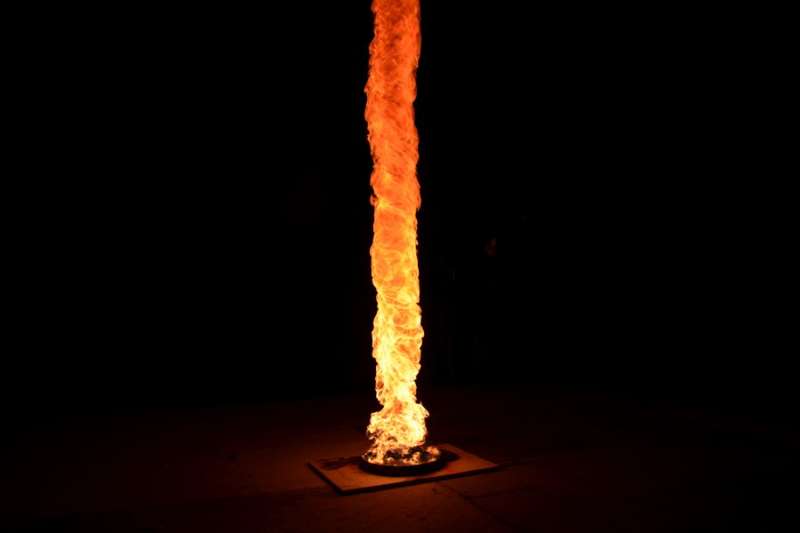Harnessing the power of fire whirls

Researchers in the University of Maryland Department of Fire Protection Engineering (FPE) have published a review of 'fire whirls' – a powerful vortex of swirling flames, often the destructive force in urban and wildland fires – in the Annual Review of Fluid Mechanics. Their size, unpredictable nature, and ability to propel burning embers (i.e., firebrands) far into the air present many reasons to study them, yet these whirling flames are still poorly understood.
The review – co-authored by FPE postdoc Ali Tohidi and Huahua Xiao, a Department of Aerospace Engineering (AE) research associate – covers the development of the field, current understanding, and a future direction for research.
The paper begins with an overview of the influential factors that govern fire whirl dynamics, such as wind speed, temperature, circulation effects, and fuel type. Fire whirls are typically formed in the laboratory by walls or fans; however, a diverse range of conditions have been observed to form fire whirls in nature, where they can reach over 1,000 feet high with temperatures over 2,000 degrees Fahrenheit. Common conditions for fire whirl formation include winds over an L-shaped fire, on the protected side of a slope, and downstream of a large fire plume. There are three criteria essential for the formation of all whirls: a fire source, a swirling mechanism (such as wind or obstacles), and a friction force at the bottom for boundary layer formation.
Circulation – a measure of the rotation of fluid particles (within a closed contour) around their center of mass – is the major factor setting fire whirls apart from non-swirling fires. In a fire whirl, the height of the flames and burning rate of the fire grows dramatically – the mechanisms responsible for these features are still under debate. Moreover, the range of conditions responsible for forming fire whirls is not yet fully understood.
"While this publication has provided a broad review of the field, necessary for future development," said Michael Gollner, FPE associate professor and principal investigator (PI) on the review, "there is still much to be done in terms of understanding how fire whirls form, their inner structure, and the effects the role they play during extreme fires."
Tohidi added, "What is most exciting about this review are the numerous opportunities for future research and development. Application of new numerical models will open our eyes to all the fascinating mechanisms occurring within fire whirls, which could be used in the future to harness their intensity for more efficient combustion."
The 'blue whirl,' a recent discovery in the UMD A. James Clark School of Engineering, presents just such an opportunity. Xiao, Gollner, and Elaine Oran (AE professor) discovered the soot-free phenomenon, which inspired the use of fire whirls to provide a more efficient solution for oil spill remediation and, potentially, clean combustion. If this form of combustion could be replicated on a larger scale, it could significantly improve the efficiency of directly burning liquid fuels. Gollner and Oran have recently received funding from the Bureau of Safety and Environmental Enforcement (BSEE) Oil Spill Preparedness Division to continue their study of fire whirls specifically for oil spill remediation.
More information: Ali Tohidi et al. Fire Whirls, Annual Review of Fluid Mechanics (2017). DOI: 10.1146/annurev-fluid-122316-045209
Provided by University of Maryland




















